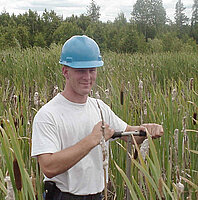Evaluation of Peat Uptake Capacity for Copper and Nickel in Constructed Wetlands of the LTV Mining Company

Eric C. Dodds. Eric received a B.S. in Civil Engineering from North Dakota State University in December 1999, and will receive an M.S. in Environmental Engineering at NDSU in December 2001. Eric accepted an engineering position with Howard R. Green Company in Des Moines, Iowa, starting June 2001.
doddseric@hotmail.com
Fellow: Eric C. Dodds, Environmental Engineering Program, Department of Civil Engineering, NDSU
Advisor: Wei Lin, Assistant Professor of Civil Engineering, NDSU
Matching Support: LTV Steel Mining Company
Degree Progress: M.S. expected in 2001.
Evaluation of Peat Uptake Capacity for Copper and Nickel in Constructed Wetlands of the LTV Mining Company
Storm water runoff from Dunka mine of the LTV Steel Mining Company (LTVSMC) has been a major environmental concern to the company and the state of Minnesota. Storm water seeping through stockpiles of overburden rocks forms runoff containing high suspended solids and elevated concentrations of heavy metals. The runoff from the site flows through an unnamed creek into the Boundary Waters Canoe Area and Wilderness, an environmentally sensitive wildlife and recreation area. To reduce the environmental impact of the runoff, LTVSMC has installed six wetland treatment systems since 1992. The wetlands were constructed with peat soils and seeded with cattails. Berms were built in the wetlands for alternation between underflow and overflow types and were used for even flow distribution. In addition to the peat and cattails, limestone is placed at both the inlet and outlet of the wetlands for pH adjustment.
The wetlands have been able to remove metals to meet the water quality standards setup in its National Pollution Discharge Elimination System (NPDES) permit. However, there have been concerns about the life span of these constructed wetlands and requirement of peat replacement in the future. The NPDES permit requires that a peat uptake evaluation be performed by LTVSMC. To meet the requirements of the NPDES permit this project was developed to provide a systematic analysis of the wetlands. The objectives of this project are:
- determination of copper (Cu) and nickel (Ni), the two major metals of concern, uptake capacity by the peat;
- study of the impact of environmental conditions, such as pH and temperature on metal uptake;
- determine the removal capacities of Cu and Ni under competitive conditions; and
- study metal removal from the actual mine runoff water.
The scope of this research included performing batch metal removal studies on synthetic metal solutions and real mine runoff water to determine the metal removal capacity of peat and studying the pH and temperature impacts on metal removal by peat. Single and mixed metal solutions were studied to determine the removal capacity under competitive conditions. Metal removal from the real mine runoff was studied and compared to metal removal from the synthetic solutions. Metal concentrations in the batch equilibrium samples were analyzed using the ICP procedure, performed by the Soil and Water Environmental Laboratory of the Soil Science Department, NDSU. Isotherm tests will be carried out in the Environmental Engineering Laboratory of the Department of Civil Engineering, NDSU.
The results of this research provided information on metal uptake capacity by the peat under different environmental conditions and on the capacity of the peat in the wetlands to remove metals from the wetland influent. Temperature affects on Cu and Ni removal were determined to be insignificant between 5°C and 20°C. Precipitation of Cu and Ni from the synthetic solutions occurred at high pH thus increasing Cu and Ni removal with increasing pH. Metal removal from the actual mine water was lower than that from the synthetic metal solutions. The low removal may be due to the high ionic strength or the high degree of complexed metals in the mine water. These results will benefit LTVSMC, regulatory agencies of Minnesota, and academic societies studying wetland and metal removal. The researchers gained better understanding of the mechanisms of metal uptake by peat through isotherm studies. The results of capacity evaluation will enable the government agencies and LTVSMC to determine the schedule for monitoring and peat replacement.


Wei Lin
Civil & Environmental Eng.
Office: Civil/Ind Eng 201D
Telephone: 701-231-6288
Email: wei.lin@ndsu.edu


